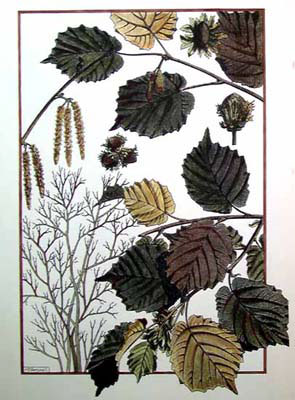The Hazel


The Hazel is the ninth month on the Celtic Tree Calendar. The Hazel is a tree of wisdom. The hazel symbolizes wisdom, intelligence, inspiration, poetic inspiration, and wrath. In England, all the knowledge of the arts and sciences were bound to the eating of Hazelnuts. Until the seventeenth century, a forked Hazel-stick was used to divine the guilt of persons in cases of murder and theft. We have retained the practice of divining for water and buried treasure. Things that have been lost can be found again, thanks to the fungi that grow on it. The mistletoe that grows on hazel protects against bewitching. If you sleep under a hazel bush you will have vivid dreams. A hazel switch is no longer the teacher's staff of office, but divining rods are always cut from it. In Celtic tradition, the Salmon of Knowledge is said to eat the 9 nuts of poetic wisdom dropped into its sacred pool from the hazel tree growing beside it. Each nut eaten by the salmon becomes a spot on its skin. The Hazel tree provided shade, protection and baskets. Hazel is always been regarded from its magical presence it inspires our intuitive senses it is also the poets tree. Is associated with fairies and entrances to magical realms. The Hazel is associated with the White Goddess and Macoll.
The Hazel does not stand out either for its beauty or size, and in the countryside it is as common as sparrows. The hazel is a pioneering plant because it prepares the ground where nothing grows for the plants that will come after it. It grows best in a mixed forest and away from beech, pine and firs. The Hazel has to be 9 years old before it can produce it's nuts. In Central Europe the hazel is widespread as a bush and a favorite with young people, for it never carries its nuts too high. Hazels can be found as trees or as small trees with many trunks. Hazels are deciduous shrubs and small trees frequently coppiced and used for hedges. The Hazel wood has been used in past for cask hoops, basketry, walking sticks, hurdles, thatching, and spars and makes good firewood. The hazel produces a nut that is very delicious and nutritious and ripens 9 months after her catkins first appeared. These impatient male harbingers of spring are called 'lamb's tails', and the small, red, star-shaped, female flowers which sit on the buds without stalks, are called 'red-styles'. The nuts develop from these. The hazel is clearly a self-fertile plant, since male and female organs can be found on the same bush, so the plant can fertilize itself.
Hazel people have the soul of a pioneer, but they waste too much energy on competitive thoughts and in fighting abuses instead of letting their own gifts and skills ripen. Hazel people can be too impatient and hurry things when they should sit back and let things take their own course. They find it hard to learn the value of old teachings and things. Don't miss something special by ignoring those things that have withstood the test of time. They are sometimes too intent on running around trying everything "new" that they forget the older values that would help them. When Hazel people listen to their own natural rhythms, they find they are happier and more prepared spiritually and physically.